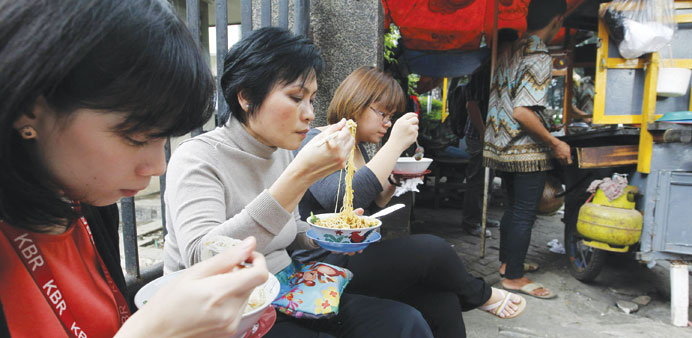Reuters/Jakarta
After a hard morning poring over his books, Indonesian student Mohammed Rezky Utama refuels with a steaming bowl of noodles, shunning the more expensive rice dishes that were once his staple diet.
Like many of his compatriots, his appetite for cheaper wheat-based foods has rocketed as he looks to save money to cope with rising inflation, pushing Indonesia close to displacing Brazil as the world’s No.2 importer of the grain.
“They are cheap, tasty, and we don’t need side dishes,” 20-year-old Utama said of noodles, often served in chili-infused broths by the tens of thousands of vendors who cram the pavements of Indonesia, home to more than 240mn people.
This uptick in demand from poorer consumers, in a country where around half the population lives on less than $2 per day, comes on top of a creeping westernisation of diets as people develop a taste for snacks that also rely on wheat flour, such as burgers and doughnuts.
The latest rise will support benchmark prices that have fallen about 14% this year, with Australia set to benefit most as its premium and standard white wheat account for the bulk of Indonesia’s imports.
Inflation in Southeast Asia’s largest economy is expected to hit 7.2-7.8% by year-end compared with 4.3% in December 2012, stoked by fuel prices that jumped an average 33% in June when subsidies were cut.
“Increased fuel prices and higher non-cereal prices are denting discretionary spending,” said Paul Deane, agricultural commodity strategist at ANZ. Indonesian rice prices have shot up as the government curbs imports and as housing is built on farmland to accommodate a growing population.
“Consumers will look to save costs - classic behaviour will be to trade down to lower-value products such as wheat noodles.” Deane says that will drive up Indonesian wheat imports to 7.5mn tonnes this year, more than the 7mn touted by industry officials before the fuel hike kicked in.
That would be a rise of between 1mn and 1.5mn tonnes from 2012, and would match shipments into current global No.2 wheat importer Brazil.
Some forecasters even see the nation surpassing Egypt as the world’s top importer of the grain within five years, although short-term competition will come from China after its current wheat crop was ravaged by frost and rain.
Grain shipments to Indonesia are also likely to receive a boost from the government’s decision to extend a 200-day emergency tariff on wheat flour imports, as it moves to protect its expanding wheat mill industry against subsidised imports.
The country imports all its wheat as its climate is too humid to grow the crop, which it uses to make noodles, bread and cakes, as well as regional favourites such as curry puffs and dumplings. Australia supplies around 65% of shipments, with Canada and the US providing most of the rest.
Underpinning growing appetite for wheat in the country in recent years has been middle-class demand for western fast foods, with McDonalds, Dunkin’ Donuts and Pizza Hut outlets mushrooming. Analysts said levels of disposable income for these more affluent consumers would remain fairly resilient to rising inflation.
The Indonesian Wheat Flour Mills Association may revise its wheat import forecast next month when new data is available, said chairman Franciscus Welirang.
Domestic rice prices have exceeded wheat flour prices since November 2011, according to Indonesian trade ministry data, with the latter now at an almost 400 rupiah ($0.04) discount per kg.

Women eat noodles purchased from a street food stall in Jakarta.
